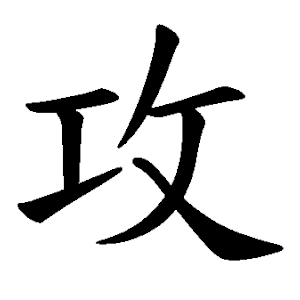攻
- to attack;
- to strike;
- to assault;
- to challenge;
Primarily means to attack or assault, both in physical and strategic senses. It also carries secondary meanings of to strive toward a goal, to challenge difficulty, or to study intensively — attacking a problem with effort and persistence.
Etymology
Phono-semantic compound composed of:
攴 (칠 복) — semantic component, meaning “to strike” or “to hit,” indicating an action of attack or application of force.
工 (장인 공) — phonetic component, giving the sound gong (공) and suggesting craftsmanship, skill, or calculated effort.
Together, they convey the idea of “applying force with skill and precision”, not blind violence but a directed, deliberate attack or effort.
Usage in Korean
攻擊 (공격) — attack; assault
進攻 (진공) — to advance in attack; offensive move
反攻 (반공) — counterattack
攻城 (공성) — to besiege or assault a city
攻守 (공수) — offense and defense
攻陷 (공함) — to capture or fall (of a fortress)
攻讀 (공독) — to study diligently (literally, “to attack reading”)
攻克 (공극) — to overcome; to conquer
攻關 (공관) — to tackle a key challenge
攻破 (공파) — to break through; to destroy
Words that derived from 攻
Additional notes
In ancient Chinese military vocabulary, 攻 described offensive operations, particularly the assault or siege of fortifications.
It implies initiative and movement, in contrast to 守 (defense), which emphasizes stability.
「攻者,動也;守者,靜也。」
“Attack is movement; defense is stillness” — Sunzi, The Art of War (孫子兵法).
In The Art of War, 攻 is central to strategy — the art of applying calculated force at the right moment:
「上兵伐謀,其次伐交,其次伐兵,其下攻城。」
“The highest form of warfare is to attack the enemy’s strategy, next to attack alliances, next to attack armies, and the lowest is to attack walled cities.”
Hence, 攻 is not merely physical aggression but tactical intelligence, initiative, and skillful execution — striking not with brute strength but with foresight and precision.
Extended meanings:
Because of its connotation of focused effort, 攻 also came to describe academic or intellectual pursuit — “to attack with study” (공부하다, 攻讀).
「學而不攻,無所得也。」
“To learn without attacking it (with effort) yields no gain.”
Thus, whether on the battlefield or in study, 攻 expresses directed energy toward mastery.
攻 symbolizes initiative, energy, and active pursuit.
It stands for the assertive force of movement and progress, the act of confronting rather than retreating.
Yet classical philosophy balances 攻 with 守 (defense), teaching that wisdom lies in knowing when to advance and when to hold.
「善攻者無怒,善守者無懼。」
“He who attacks well is not driven by anger; he who defends well is not ruled by fear.”
攻 reveals that true strength is measured not by destruction, but by precision and purpose.
It is the art of directed will — to engage, to challenge, to advance — always tempered by understanding.
「以智攻難,以毅攻成。」
“Use wisdom to attack difficulty; use perseverance to achieve success.”
Thus, 攻 stands as a symbol of skillful effort and courageous initiative, the active power that transforms challenge into mastery.
